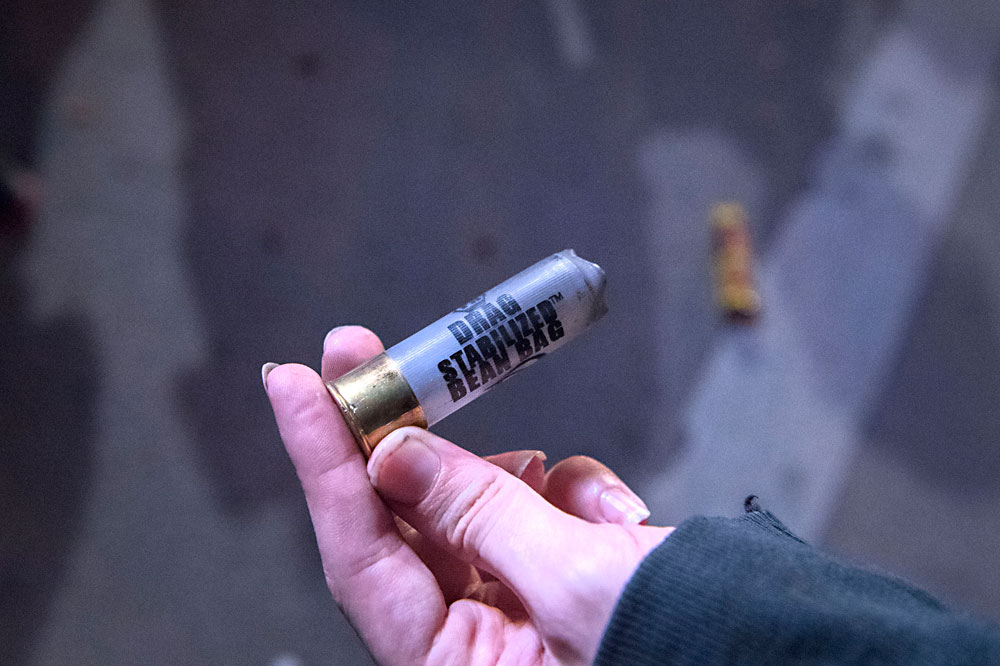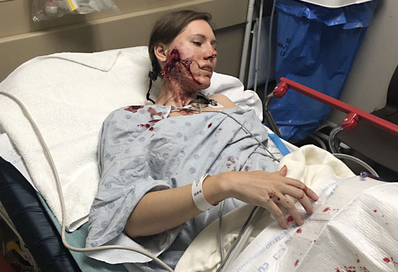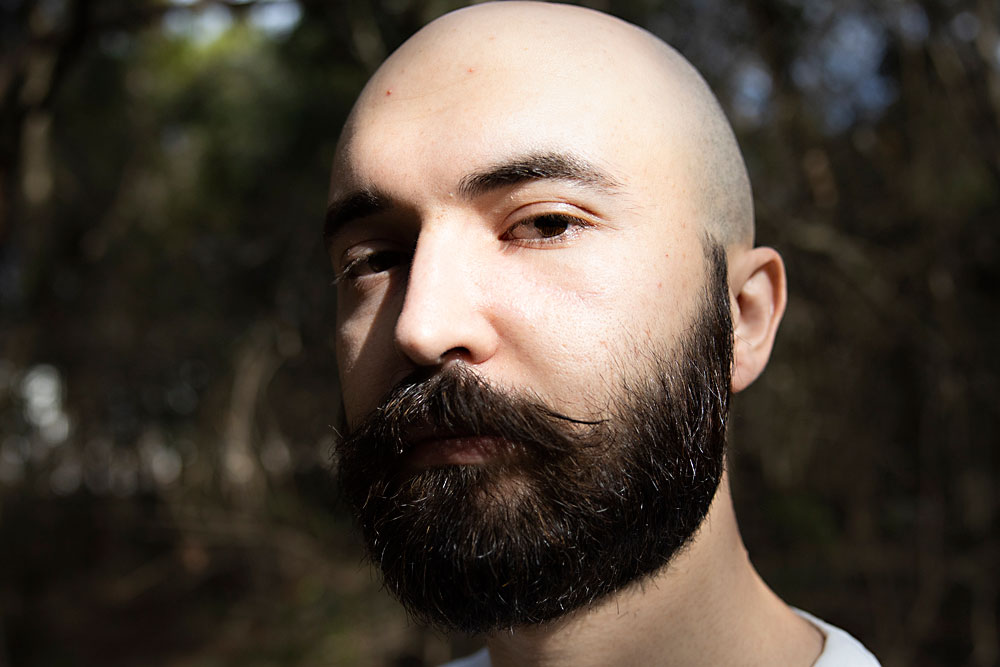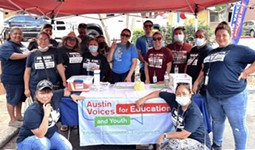Eighth Street Survivors Still Wait for Resolution From the City and APD
Sixteen months later, civil and criminal cases move slowly
By Brant Bingamon, 8:30PM, Wed. Sep. 29, 2021

To the Austin Police Department, the thousands of people who gathered Downtown to protest for Black lives over the weekend of May 30-31, 2020, were rioters.
Thus, APD responded to the demonstrations, particularly those near its headquarters at E. 8th Street that at times spilled onto I-35, with violence intended as riot control. They beat and gassed protesters and shot dozens with “less lethal” munitions, such as lead-pellet “bean bag” rounds.
Nearly a dozen of the most seriously injured survivors are suing the city of Austin, and while the Travis County District Attorney’s Office prepares to present cases to a grand jury, the Office of Police Oversight and justice advocates have loudly decried APD Internal Affairs’ handling, or not handling, of the complaints detailed in the lawsuits. With attention returning to these allegations of misconduct, stories like that of Tyree Talley are resurfacing.
Talley, a 27-year-old Black and deaf Austinite, attended the protests out of curiosity. At about 9pm on the evening of May 30, he and several deaf friends were milling among hundreds of other demonstrators on the blocked frontage road facing APD headquarters, chatting in American Sign Language. Without warning, Talley felt something hit his ear. A bean bag round had been fired at his head by a still-unidentified officer standing on the steps of the APD plaza, missing his eye by an inch. A second later, another round hit Talley in the groin.
“That's when I fell down on the ground,” Talley told the Chronicle through an interpreter. “And then my eyes were closed and [the shots] just kept going. I tried to protect my eyes — as a deaf person they’re so critically important to me. Because like, it could make me go blind. Then I'd be blind on top of this.”
As he lay in the street in the fetal position, Talley was shot 10 more times in the ankles, legs, arms, and back. A friend he’d been standing next to, Modesto Rodriguez, was shot in the ankle and ribs. When the shooting stopped, protesters helped the men limp back to Talley’s SUV, three blocks away. Rodriguez drove to St. David’s Medical Center as Talley lay in the back, bleeding over the seats.
For days after the shooting, Talley stayed in bed, trying not to move. “I was almost frozen with pain that next day. I just felt like I was trying to limit my movement because it hurt so bad. I didn't do anything but sleep, really, just for a few days. That's all that I was able to do.”
Before the shooting, Talley had been a bartender and sous chef. Now, as he slowly recovered, he was unable to work, unable to pay his bills. He was evicted from his apartment and slept on friends’ couches and in a tent. During February’s winter storm he went days without food. He finally got back into housing in July and is working as a server and delivering meals in a borrowed car.
Talley says he feels fine now, physically, though he has several two-inch-wide, circular scars. But the shooting haunts him emotionally. “It causes me anxiety. I feel like I kind of have to keep a protective shell sometimes when I'm around people and I'm just not as involved as I used to be in life around me. I have had less contact with my family from it and I feel, like, defensive of myself. Before this happened I felt motivated. I felt confident. And now I'm like – you know that kind of playful banter with people? Like, I just can't tease people back and forth now. I don't have confidence to do stuff like that anymore.”
In March, Talley hired Rebecca Webber of Webber Law, who specializes in cases of civil rights abuses by police. Webber is also representing Talley’s friend Modesto Rodriguez; other protesters who were hurt during the protests, like Sam Kirsch; and Brenda Ramos, the mother of Mike Ramos, the unarmed Black and Hispanic man whose killing by APD in April of 2020 helped spark the May 30-31 protests.
Webber filed Talley’s lawsuit in March and has just begun the discovery phase of the case, where she can begin collecting information held by the city on the shooting. She’s deeply frustrated that APD still has not disciplined – or, in Talley’s case, even identified – any of the officers who shot protesters last year.
She also would like to see members of the City Council direct the Office of the City Attorney to abandon its defense of the officers who hurt protesters and settle the lawsuits immediately. “Look, I do have some sympathy for Council dealing with the complicated politics around police accountability,” Webber said. “Almost all of them expressed the appropriate level of disgust last summer, but come on, it's been over a year. I have clients with life-changing injuries and lasting trauma and quite frankly, Council is not doing enough to right the City’s wrongs.”

Another Unlikely "Rioter"
Christen Warkoczewski is another of those hurt during the protests who APD would accuse of riotous behavior. But she certainly doesn’t fit the profile of a radical. The 30-year-old Austinite grew up in West Lake Hills, works as a wildlife biologist, and is so newly married that she still refers to her husband as her fiance.
Feeling it was her civic duty, Warkoczewski attended the protests on the afternoon of May 31, climbing onto the highway at the Eighth Street overpass with a group of demonstrators. A line of heavily armed police assembled and launched tear gas canisters at the group. With the gas drifting near, Warkoczewski picked up a traffic cone at the edge of the highway and placed it over a smoking canister. She turned, ran back approximately ten feet, and was hit by bean bag rounds in the face and ankle. She stumbled, getting a full dose of the gas.
“It was affecting my throat and my lungs and I'm trying to hold my mask on,” Warkoczewski said. “Gasping makes it worse. I guess. It was like trying to prevent yourself from breathing in water while you're drowning. Like your body so badly wants air, but you can't take a big gasp of air because it's just going to make it worse. [And] I could feel something wrong with my cheek. It felt like there was an egg-sized mass in my face – which there was.”
A bean bag round – a mesh bag filled with lead shot – had penetrated the outer layer of skin at the hinge of Warkoczewski’s jaw, lodging near a pocket of muscle but not continuing all the way into her mouth. Limping and blinded by the gas, she was led off the highway and down the embankment to volunteer street medics.
“I couldn't talk at all because I couldn't breathe. I couldn't catch my breath. So these two people carry me down the embankment and get me down to the curb, at which point there's just blood pouring from my face…. And I remember being really concerned about my hat for some reason, because it was my hat that I wear for fieldwork. But in the meantime, I have this foreign mass hanging out of my face.”
Warkockzewski was transported to the hospital, where she learned that bones in her jaw had been fractured. A part of the jaw known as the filial had been obliterated. Still, it could have been worse. Doctors told her that if the round had landed an inch over in any direction she would have been killed or had major nerve damage.
Like Talley, Warkoczewski was unable to work for months after the shooting. When she did return her performance was erratic. At first, she didn’t want to admit that anything was wrong. Eventually, she began treatment for depression. A second surgery in October 2020 was followed by physical therapy.
“It's been really stressful,” Warkoczewski said. “I don't want to do [physical therapy] because it hurts. But if I don't do enough, I'm never going to be the same. [And] I need my face for face things, like eating and talking and kissing my fiance. But I still don't have an entirely full range of motion and sensation and movement. And nerves take forever to heal.… I had to be on a liquid diet for a little while, while the fractures in my jaw healed, and I basically haven't completely transitioned off of that because eating is just really tiring now. Like I get tired after eating one slice of pizza. I don't get full, but I get tired of eating pizza, because it's really hard for me to chew on the one side, because my cheek doesn't move right now.”
The emotional effects continue as well, as she learned when she and her husband attended a Fourth of July celebration this summer. “I didn't think it was going to affect me but I was already stressed out from being around people, and then I suppose, ‘We should do a firework’ – it sounds like fun, fireworks are pretty. It'll be fine, right? It was not. It's obvious in retrospect: ‘Oh, you got shot, probably sudden loud noises from explosives are not going to be super fun anymore.’ But you know until it actually happened, I didn't think it would happen to me.”
Warkoczewski signed on with longtime Austin civil rights attorney Bobby Taylor shortly after her shooting. Taylor recently joined forces with Jeff Edwards, who is representing many protesters hurt by police on May 30-31, including Justin Howell and Anthony Evans, whose devastating injuries the Chronicle reported on last February.
Taylor and Edwards filed a lawsuit on behalf of Warkoczewski in August, which reiterates the point that none of the officers who shot protesters, or their superior officers who authorized the force, have been disciplined. The lawsuit states that former Police Chief Brian Manley knew of the dangers of firing projectiles into crowds, and knew that many people had been hurt on May 30, but made no changes to his orders on May 31. In fact, according to the lawsuit, he suspended the requirement that officers document their uses of force during the protests, freeing them to use as much force as they desired.
Warkoczewski is not a seasoned activist, just a concerned citizen, but she wants to see APD held responsible for what it did to the Black Lives Matter protesters. “The fact that there's multiple people who had to have surgery to have these rounds removed is pretty horrific. And the best we've been able to get from the cops so far has been, ‘We won't shoot them into crowds anymore,’” she said. “It’s so disheartening, all the legal news and the lack of consequences.”
"I Can't Really Hide That"
For Sam Kirsch, the sixteen months since his shooting have been about trying to save his left eye, which was nearly destroyed by officer Rolan Rast, allegedly, on May 31, 2020. Like Warkoczewski, Kirsch had climbed onto I-35 that afternoon. Like her, he was shot in the face as he fled the police.
Kirsch endured a fourth surgery on the eye two weeks ago which removed cataracts that developed after a previous surgery and from the injury itself. Doctors are telling him the eye will always be compromised. “Basically my vision isn't really going to get any better so much as it's hopefully not going to get worse,” Kirsch said. “More or less half of the field of view is gone. What's remaining is a bit blurry and distorted and I’m still seeing double vision and floaters. So, you know, probably all of those are always going to be there.”
Kirsch also suffers from nerve damage that manifests as numbness, tingling, and pain in his upper lip and nose. This is probably permanent as well. Then there is the eye twitching. “It's called blepharospasm,” Kirsch said. “They’re involuntary eyelid twitches and it's something that, medically, doctors don't have a full understanding of. [T]hose have become quite, quite annoying because everything else I can kind of interact with people and people can’t necessarily notice [the injury], especially if I wear glasses. But the eyelid twitches, I can’t really hide that.”
Though he’s a stoic person, Kirsch’s injuries have had cascading emotional effects. He’s been unable to return to work and feels stuck, waiting for a resolution that could still be years away. “I'm at a place where I'm really not sure what I'm going to be able to do. What it comes down to is, what will I be able to do safely? Because the only jobs I've ever really had were in food – I have a culinary arts degree and I've only worked in restaurants and then in food consulting, and everything is in a kitchen and kitchens are just very dangerous places.”
Another thing keeping him from returning to work is the constant need to see doctors. “There are so many periods where I'd have at least one or two appointments every single week,” Kirsch said. “At a certain point I'm like, what's the point even of trying to look for something? If, you know, I don't even think I can do it?”
Kirsch’s trial is set for November of 2022. But if Rast winds up being indicted on criminal charges related to the shooting – a new grand jury convenes in October – the civil trial could be delayed to allow the officer to fight the criminal charges first.
When a resolution does come, Kirsch hopes that his story will have helped to bring change. “I don’t want to end up in a situation where I get some sort of compensation but then nothing happens in terms of change, in regards to what happens to the officer who shot me, in regards to how APD goes about doing things,” Kirsch said. “I mean, they still haven't even admitted that they shot me.”
Got something to say on the subject? Send a letter to the editor.
A note to readers: Bold and uncensored, The Austin Chronicle has been Austin’s independent news source for over 40 years, expressing the community’s political and environmental concerns and supporting its active cultural scene. Now more than ever, we need your support to continue supplying Austin with independent, free press. If real news is important to you, please consider making a donation of $5, $10 or whatever you can afford, to help keep our journalism on stands.
April 19, 2024
April 19, 2024
Austin Police Department, Eighth Street shootings, Black Lives Matter, Tyron Talley, Rebecca Webber, Christen Warkoczewski, Bobby Taylor, Jeff Edwards, Sam Kirsch









